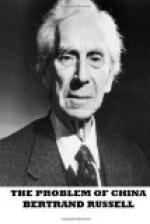The Occidentals have singularly contracted the field of the history of the world when they have grouped around the people of Israel, Greece, and Rome the little that they knew of the expansion of the human race, being completely ignorant of these voyagers who ploughed the China Sea and the Indian Ocean, of these cavalcades across the immensities of Central Asia up to the Persian Gulf. The greatest part of the universe, and at the same time a civilization different but certainly as developed as that of the ancient Greeks and Romans, remained unknown to those who wrote the history of their little world while they believed that they, were setting forth the history of the world as a whole.
In our day, this provincialism, which impregnates all our culture, is liable to have disastrous consequences politically, as well as for the civilization of mankind. We must make room for Asia in our thoughts, if we are not to rouse Asia to a fury of self-assertion.
After the Han dynasty there are various short dynasties and periods of disorder, until we come to the Tang dynasty (A.D. 618-907). Under this dynasty, in its prosperous days, the Empire acquired its greatest extent, and art and poetry reached their highest point.[10] The Empire of Jenghis Khan (died 1227) was considerably greater, and contained a great part of China; but Jenghis Khan was a foreign conqueror. Jenghis and his generals, starting from Mongolia, appeared as conquerors in China, India, Persia, and Russia. Throughout Central Asia, Jenghis destroyed every man, woman, and child in the cities he captured. When Merv was captured, it was transformed into a desert and 700,000 people were killed. But it was said that many had escaped by lying among the corpses and pretending to be dead; therefore at the capture of Nishapur, shortly afterwards, it was ordered that all the inhabitants should have their heads cut off. Three pyramids of heads were made, one of men, one of women, and one of children. As it was feared that some might have escaped by hiding underground, a detachment of soldiers was left to kill any that might emerge.[11] Similar horrors were enacted at Moscow and Kieff, in Hungary and Poland. Yet the man responsible for these massacres was sought in alliance by St. Louis and the Pope. The times of Jenghis Khan remind one of the present day, except that his methods of causing death were more merciful than those that have been employed since the Armistice.
Kublai Khan (died 1294), who is familiar, at least by name, through Marco Polo and Coleridge; was the grandson of Jenghis Khan, and the first Mongol who was acknowledged Emperor of China, where he ousted the Sung dynasty (960-1277). By this time, contact with China had somewhat abated the savagery of the first conquerors. Kublai removed his capital from Kara Korom in Mongolia to Peking. He built walls like those which still surround the city, and established on the walls an observatory which is preserved to this day. Until 1900, two of the astronomical instruments constructed by Kublai were still to be seen in this observatory, but the Germans removed them to Potsdam after the suppression of the Boxers.[12] I understand they have been restored in accordance with one of the provisions of the Treaty of Versailles. If so, this was probably the most important benefit which that treaty secured to the world.




